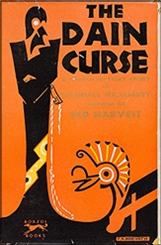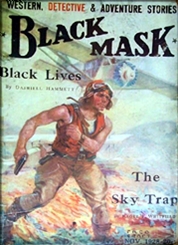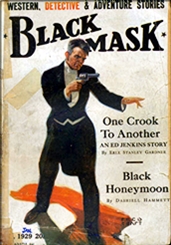Wed 20 Dec 2023
Reviewed by Tony Baer: DASHIELL HAMMETT – The Dain Curse.
Posted by Steve under Pulp Fiction , Reviews[10] Comments
DASHIELL HAMMETT – The Dain Curse. Alfred A. Knopf, hardcover, 1929. Reprinted many times since, in both hardcover and paperback. TV mini-series: CBS 1978 (starring James Coburn as “Hamilton Nash”).

The Dain Curse is a bad novel cobbled together from four interlinked stories from Black Mask. I disliked the novel when I first read it many years ago. Then after a recent debate on the Rara-Avis listserve about its merits, I resolved to read it again. This time reading the four stories as originally published to see if that improved my experience. It didn’t.
Taking the four stories separately, however, there are some ebbs and flows of merit. It is Hammett after all. And bad Hammett is still better than a lot of stuff out there. I just wouldn’t recommend a re-read is all.
Story 1: “Black Lives.” (Black Mask, November 1928)
The Continental OP is hired by an insurance company to investigate stolen diamonds. Edgar Leggett had been loaned the diamonds by a local jeweler for the purpose of conducting some experiments adding hue to the stones. The OP begins to suspect that there’s something fishy about the so called theft.

And bad things happen to Leggett and his family. Leggett’s daughter, Gabrielle, is informed by her step mother that all of the badness can be traced to a family curse (her mother’s maiden name was Dain): The Dain Curse: “[Y]ou’re cursed with the same rotten soul and black blood…all the Dains have had, you’re cursed with your mother’s death on your hands before you were five; you’re cursed with the warped mind and the need for drugs that I’ve given you in pay for your silly love since you were a baby. Your life will be black as…mine [was] black; the lives of those you touch will be black”.
In the end the OP solves the crime of the missing diamonds, the insurance company is happy. But the Dain Curse remains!!
Story 2: “The Hollow Temple.” (Black Mask, December 1928)
By far the best of the four stories, in this one Gabrielle Leggett joins a cult and goes missing. The OP is hired by her fiancé to recover the girl — which he does — but not before crushing the hollow temple forged by a charismatic charlatan out of morphine, laughing gas, sight gags, and mullah.

Story 3: “Black Honeymoon.” (Black Mask, January 1929)
Once Gabrielle Leggett is saved from the hollow temple, her fiancé elopes with her. The honeymoon does not go well, and the OP is called in to pick up the shards.
Story 4: “Black Riddle.” (Black Mask, February 1929)
The so called riddle is this: If you don’t believe in Dain curses, why are all these bad things happening to Gabrielle Leggett? In this horribly told story, the OP mansplains for all to hear the solution to the three prior stories.
He doesn’t show us. He tells us. Giving us a bunch of undisclosed information based on unsupported guesswork that just so happens to be completely right and confessed to by the criminal mastermind. It’s absolutely the worst kind of ending of a mystery. No fair play. No show don’t tell. Just a boring dispositive lecture telling you the answer in a terribly unsatisfying way.
—

So yeah. Hated it. Almost couldn’t finish it. Upon starting the book I immediately remembered who the ‘criminal mastermind’ was. This made my experience of the book infinitely worse as I could witness the lack of fair play in real time as the story unfolded.
If Fast One is ODTAA (thanks, Roger) – -for whatever reason Hammett eschews ODTAA, insisting on a criminal mastermind to tie all of the miscreants and their collective miscreantry together. It’s an unnecessary conceit that spoils the whole thing. Ironically the curse of the Dain Curse is that there’s no Dain Curse.
If Hammett had simply allowed the curse to linger all might have been okay. But Hammett takes such pains to dispel the curse that he destroys whatever mystery is left. Rather than solving the case, the whole thing crumbles in a monologue that neatly ties up everything in a bow. But what results is neither trick nor treat. Turns out the Dain Curse is the cursed book itself.
December 20th, 2023 at 7:42 pm
Tony,
Completely agree with your review. I’ve read this book four times in the last fifty years and still don’t like it! And like you I’ve also read the stories themselves in my copies of BM. Still doesn’t work for me. That being said, Hammett is my #1 author of mysteries! I’ll just stick to Red Harvest and all those wonderful OP short stories!!
December 21st, 2023 at 9:44 am
I don’t say your criticisms aren’t well-taken, but bad Hammett is still better than good anybody-else, and the Continental Op the greatest hard-boiled private eye character there is.
Consequently, THE DAIN CURSE is, for all its imperfections, still one of the greatest private eye novels ever written.
December 21st, 2023 at 10:37 am
Jim,
If somehow one could ignore the 4th and final story, “Black Riddleâ€, the whole calculus would change. It’s like Hammett was forced to connect the prior three stories with an outlandish fourth one. Taking the three prior Dain stories on their own merits they’re good and ‘Hollow Temple’ is top shelf. It’s just that Black Riddle is the worst Hammett story bar none, and I’ve read them all. And in novel form, Black Riddle is like an anchor sunk thru the hull of an otherwise seaworthy ship.
December 22nd, 2023 at 9:26 am
Tony,
I see your point. And of the four segments, Part IV is, admittedly, the weakest. Yet I recall reading that part of the book for the first time, and being riveted. I couldn’t put it down!
Did it hang together the way an Ellery Queen novel or a John Dickson Carr short story would? No. But Hammett wasn’t a puzzle-maker. He was a storyteller. He wasn’t about hiding clues, but about getting you to turn the pages.
Was the “linked short stories cobbled together to make a novel” fix-up more evident than in the other two Op novels? Sure. BLOOD MONEY was only two segments and one flowed into the other more easily. And in RED HARVEST (and in THE GLASS KEY, too, though it wasn’t an Op novel) the seams are much better concealed. CURSE, with its Mansion, Temple, Vacation Spot, Courtroom settings marking each segment so clearly, doesn’t even attempt to conceal its “each installment is also a self-contained story” structure.
But I recall not being able to put it down the first time I read it, and I’ve had the same reaction every time I’ve reread it.
It’s still one of the best PI novels ever. For me, it always will be.
December 22nd, 2023 at 10:40 am
I am with you, Jim.
December 22nd, 2023 at 11:09 am
An earlier review by Curtis Evans and 28 comments! found here:
https://mysteryfile.com/blog/?p=10965
December 22nd, 2023 at 2:02 pm
And totally forgotten by me. Thanks, Tony!
December 23rd, 2023 at 1:09 am
Agreed it is minor Hammett, and it feels as if the third and fourth parts are rushed, as if Hammett had and idea developing and it didn’t pay out and he just tied it up as best he could and sold it as a fix-up on the basis of RED HARVEST.
It still shows Hammett’s virtues, it’s just must weaker, perhaps because he doesn’t trust the theme or the story.
The mini-series works a bit better because you have James Coburn and Jason Miller in it, but it is easily the weakest Hammett book, which is praising with faint damn’s considering Hammett’s overall quality and value.
I would not be at all surprised to find Hammett had the idea for FALCON while finishing this, and decided he was bored with the Op and ready to move on.
December 23rd, 2023 at 4:27 pm
David,
I would say that BLOOD MONEY is the weakest of his novels. Though the first segment is riveting (until it gets a little monotonous; you find yourself wondering why the survivors keep on falling for this gambit), and the second segment not bad, and though they fit together better than the four segments of DAIN, it’s too short to be really satisfying as a novel.
In fact, though it was published as a novel in both hardback and paperback, it’s often not even regarded as one of his novels.
It was not even included in the US edition of the omnibus collection THE NOVELS OF DASHIELL HAMMETT (though it was included in the UK edition).
January 4th, 2024 at 9:45 pm
Maybe not Hammett’s best but it still held my interest. It was, I suspect, daring at the time dealing with drug addiction and religious cults. And better than the TV miniseries.